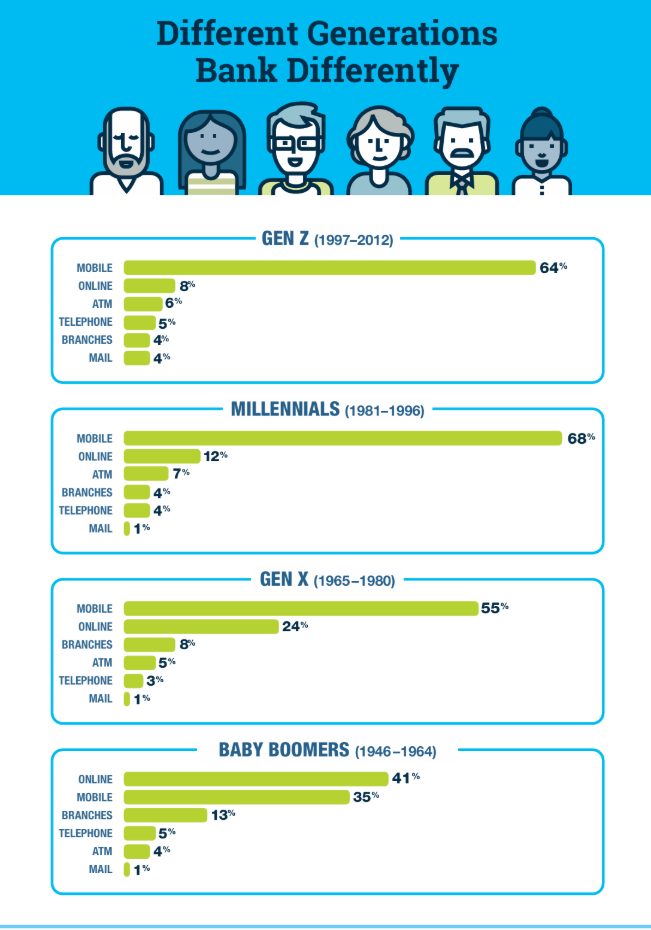Our website uses cookies to ensure functionality and provide a better experience. Learn more about how we use cookies in our privacy policy.

In today's multi-generational marketplace, one-size-fits-all marketing just doesn't cut it anymore. To stay ahead of the competition, banks and credit unions need to speak the digital language of each generation. But how do you effectively target Boomers, Gen X, Millennials, and Gen Z without stretching your marketing team thin?
Don't worry – we've got you covered. In this article, we'll break down targeted strategies to help your financial institution connect with every age group.
Ready to master the art of generational marketing? Let's dive in!
How Each Generation Banks (and Where You Fit In)
Baby Boomers (Born 1946–1964)
Baby Boomers grew up balancing checkbooks, not apps—but that doesn’t mean they’re unreachable. While they’ve adopted online banking, many still prefer in-person visits and desktop computers for managing their finances. This generation values clarity, personal service, and stability.
About 41% of Boomers still prefer desktop banking, and 13% frequent branches more than any other group. Email remains a reliable communication channel, and Facebook continues to be a go-to platform for Boomers seeking information.
Many Boomers are nearing or in retirement, so they’re generally not looking for new mortgages or big loans. Instead, they may be interested in retirement planning tools, refinancing existing mortgages, or home equity loans, that can help fund their retirement lifestyle. They also tend to carry higher debt than previous generations did at their age, so consolidating debt is also a concern for them. Marketing messages that show how your bank can reduce monthly payments or offer no-fee accounts can appeal to Boomers’ desire for financial peace of mind. And don’t forget – while Boomers may be late digital adopters, they value good customer service and honesty above all. Show them your institution can be a dependable partner for their hard-earned savings.
When marketing to Boomers:
You’ll want to optimize your local SEO strategy here. Boomers often search for terms like “best CD rates near me” or “trusted bank in [city],” so appearing in those results gives your institution a natural edge.
Generation X (Born 1965–1980)
Gen Xers bridge the gap between analog and digital. They’re digitally competent, often pressed for time, and looking for value. They also tend to be juggling mortgages, kids’ education costs, and retirement savings—all at once.
Over half of Gen X now say mobile apps are their preferred banking method, but nearly a quarter still use desktop online banking. This generation does their research and expects personalized, practical offers.
When marketing to Gen X:
Make your promotions feel like time-savers, not time commitments. And consider how Gen X values loyalty—once they trust your brand, they’re likely to stay with you.
Millennials (Born 1981–1996)
Millennials are digital natives, but they’ve also lived through a recession, housing crises, and the rise of fintech. They expect banks and credit unions to offer sleek, transparent, and mobile-first experiences.
Roughly 68% of Millennials rely primarily on mobile banking. They value financial literacy, personalization, and brands that align with their social values. They're also the most likely generation to switch financial institutions based on poor digital experiences.
Millennials heavily use platforms like Facebook (87% use it weekly), Instagram (71%), and YouTube, plus many are on Twitter, Snapchat, and even TikTok. Social media marketing is highly effective with this crowd, especially (and perhaps only) if done authentically. Millennials trust influencers and peer reviews; influencer marketing and user-generated content can go a long way in building credibility with them. Don’t count out email though – interestingly, Millennials love email for brand communication even more than other groups (64% listed email as a preferred channel). The takeaway: a strong multi-channel presence (mobile apps, social media, email, and content marketing) is crucial to engage Millennial customers. And whatever the channel, optimize everything for mobile, from your website to online loan applications, because Millennials will bounce if the user experience is clunky on their phone.
When marketing to Millennials:
This generation responds best to marketing that feels useful, not pushy. Think “how to save for your first home” rather than “low mortgage rates—apply now.”
Gen Z (Born 1997–2012)
Gen Z is the new kid on the block for banks – the oldest are in their mid-20s and just establishing financial independence. They are true digital natives: Gen Z has never known a world without smartphones, apps, and Wi-Fi. Accordingly, they are highly mobile-centric in their banking and most have never set foot in a bank branch. They're highly skeptical of traditional institutions but open to those that provide fast, personalized, mobile-first service.
Gen Z has a very short attention span for content, so you have only seconds to make an impression. Eye-catching visuals, memes or humor, and messaging that gets to the point quickly will work best. This generation also increasingly turns to non-traditional search engines like TikTok, YouTube, and even ChatGPT when looking for advice or recommendations. Instead of Googling 'best bank for students,' they might ask ChatGPT directly or watch a quick video on saving money. Ensuring your brand has a presence in those spaces can make a meaningful difference. Additionally, Gen Z increasingly uses AI-powered tools like ChatGPT to get quick answers to financial questions—whether it's understanding credit scores or comparing savings accounts. If your messaging, offers, and FAQs are optimized for AI-driven platforms, you’ll improve your visibility and credibility in these emerging search channels. Marketing to Gen Z is all about trust and convenience. They’re interested in building credit, saving money, and budgeting smartly but they want to learn these things quickly and efficiently, with minimal friction or fluff.
When marketing to Gen Z:
Marketing to Gen Z is all about trust and convenience. They’re interested in building credit, saving money, and budgeting smartly—but they want to learn these things in 30 seconds or less.

Mobile banking now leads across every generation, with Gen Z (68%) and Millennials (64%) showing the strongest preference for apps—while Baby Boomers still lean more on online and branch banking.
Smart Strategies for Cross-Generational Success
Understanding your audience is step one. Step two is translating that understanding into campaigns that scale across different channels, platforms, and compliance requirements. Here’s how.
1. Segment and Personalize
Your audience isn’t monolithic, and your campaigns shouldn’t be either. Use CRM and behavior data to:
Using personalization powered by AI for Financial Marketing can dramatically improve performance while maintaining efficiency.
2. Align Channels with Demographics
There’s no need to be everywhere—just be where your audience is:
It is important to maintain consistency across channels. While each generation might enter through a different door, they should all encounter a cohesive brand experience. That means your messaging tone and branding should align, even if tailored. This multi-channel orchestration can get complex, which is why many banks turn to a digital marketing agency that knows how to navigate each platform’s nuances. The bottom line: go where your customers are. If you execute on the right mix of channels for each generation, you’ll maximize engagement without wasting effort (and budget) on a platform that your target audience ignores.
3. Optimize for Mobile First
If there’s one common thread uniting Gen X, Millennials, and Gen Z, it’s that the smartphone is now the primary screen for banking. Even Boomers are using mobile apps more each year
Ensure:
Also consider SMS marketing, push notifications, and app messaging—but always ensure users have opted in.
The takeaway for mobile is simple: design for the smallest screen first. People now open their banking apps 17 times a month on average and they expect to interact with your marketing just as fluidly on those apps or mobile web. By embracing mobile marketing from mobile ads to SMS to a slick app experience, financial institutions can capture customers where they spend the most time: on their phones.
4. Automate and Scale with AI
Your marketing team can’t manually run separate campaigns for every age group—but AI can help:
Embracing AI and automation is essentially how you “stretch” your marketing capacity without stretching your team thin. The technology acts like extra team members working behind the scenes. When used right, AI can be your secret weapon to deliver highly tailored, multi-generational marketing at scale – something that would have been nearly impossible to do manually.
5. Stay Compliant and Inclusive
Marketing in the financial industry comes with responsibility. Always:
Remember, a marketing strategy that tailors itself to all generations is great, but it has to play by the rules. By building compliance checkpoints into your campaign planning, you safeguard your institution’s reputation and maintain the trust of customers from Boomers to Zoomers.
One Brand, Many Audiences
Generational marketing isn’t just smart, it’s necessary. From desktop-loving Boomers to mobile-native Gen Z, each group interacts with your brand differently. By tailoring your digital marketing efforts to different platforms and investing in tools like mobile optimization, AI, and geo-targeted ads, you can meet each audience where they are without sacrificing scale, consistency, or compliance.
Need help tailoring your marketing strategy across generations? Fill out the contact form below!
Most of our clients like us enough they stick with us for the long term. We think you will too.
